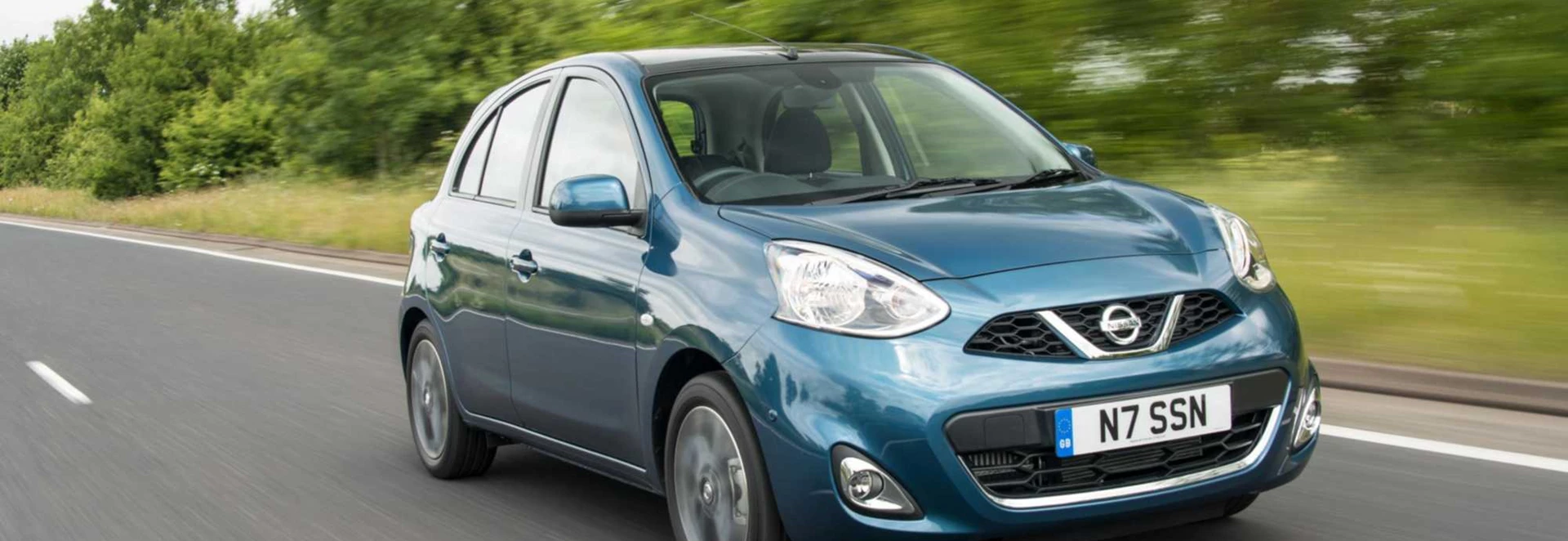The Nissan Micra is best known for being a budget runaround, favoured by old ladies doing their weekly shop. But the brand is busy trying to appeal to younger customers too, and hopes this refreshed model with a new-fangled front end will help its cause.
The styling changes were introduced back in autumn 2013 and the most noticeable differences include a new front face. The grille, bonnet and lights now more closely resemble the bulbous design of its Qashqai and Juke siblings. Also changed is the interior design complete with a new centre console.
With its new looks and some other minor tweaks, the fourth-generation Micra aims to challenge supermini competition like the Ford Fiesta and Renault Clio.
Performance
There are just two engines available in the Micra, both of which are 1.2-litre three-cylinder petrol units. We tested the most powerful option, which is a 1.2-litre DIG-S supercharged unit producing 97bhp. This was mated to a five-speed manual gearbox. The alternative engine choice is cheaper but only produces 79bhp.
Although sitting at the top of the range in terms of power, the 1.2-litre DIG-S engine is still very subdued, taking 11.3 seconds to complete the zero to 62mph sprint. No matter how much you work the gearbox, it just seems very difficult to get some life out of the little three-cylinder.
Even though the Ford Fiesta’s 1.0-litre EcoBoost three-cylinder is only 0.1 seconds faster at 11.2 seconds, the Micra still seems to lack considerable oomph.
Ride and Handling
The light feel of the Micra’s steering falls in line with many other superminis and city cars
The light feel of the Micra’s steering falls in line with many other superminis and city cars, making parking manoeuvres very easy. Unfortunately, the steering stays light even at motorway speeds, which can be quite unsettling. It lacks feedback as well, meaning it is difficult to keep track of where the front wheels are when cornering. It doesn’t get any better when it comes to body roll either, or its unsettled suspension. There is also plenty of cabin noise to boot, particularly from the rumbling three-cylinder engine. When you put this in perspective against the sharp handling of the Fiesta or the brilliant grip of the Clio, the Micra doesn’t even come close to its strongest rivals.
Interior and Equipment
Between 1992 and 2010 the Micra was manufactured at Nissan’s UK production plant in Sunderland. During this period over 2.3 million examples were built in Britain
There are three trims to choose from in the Micra, staring with Visia and followed by Acenta and then Tekna. Entry-level Visia models come with a decent amount of kit, with Bluetooth, USB connectivity and front electric windows all thrown in. Air conditioning, however, is an optional extra. The mid-range Acenta model we had added a few luxuries like climate control, cruise control and a height adjustable driver’s seat. The latter is worth noting as it can be a little awkward getting comfortable in the Micra, especially if you don’t have the option to boost your seat up. Controls are easy to understand, while general build quality in the cabin is solid and easy to understand. Cheap plastics are plentiful, but this is part and parcel of owning a Micra – durability is a key word. Storage space in the cabin is also really good, as you have two gloveboxes, handy cup holders and reasonably sized door bins. Rear passenger space and boot space in the Micra is more or less on par with the rest of the supermini crowd. Leg room is limited – but par for the course – and its head room is generous thanks to its bubble-like roof design. There is 265 litres on offer in the boot, which is a tad less than the Fiesta which offers 290. The Micra makes up for this with its seats folded down though, with 1,132 litres compared to the Fiesta’s 974 litres. The Renault Clio still pips both models however, with 300 litres in the boot and 1,146 litres with the seats down.
Cost
At £8,995, the Micra’s entry-level model trumps the Ford Fiesta and Peugeot 208
The basic Visia model starts at £8,995 – but for our 1.2-litre DIG-S with Stop/Start in Acenta trim, you’ll have to pay £13,045. At £8,995, the Micra’s entry-level model trumps the Ford Fiesta and Peugeot 208 (£9,995) as well as the Renault Clio (£10,995), so it certainly gets the budget vote. Although the DIG-S supercharged engine is the most powerful engine in the Micra range, it is also the most fuel efficient, emitting as little as 95g/km (meaning its road tax free) and returning an average of around 60mpg. Bear in mind however, the £8,995 entry level price will get you the regular 79bhp 1.2-litre three-cylinder petrol, which carries CO2 emissions of 115g/km, which means an annual road tax bill of £30.
Our Verdict
The Nissan Micra has undoubtedly improved since its raft of updates arrived in late 2013. The Micra’s interior is nothing special, but is practical and built to last. Its drive and overall refinement is what really trips it up. In these two areas the car is way behind the class leading Ford Fiesta. However, when you consider that this is a run-around car above anything else, a fun-to-drive feel may not be a top priority. The key boons of the Nissan Micra are its durability and low cost. If this is all you are after, then the full package offered by the Ford Fiesta probably won’t even enter your mind.




